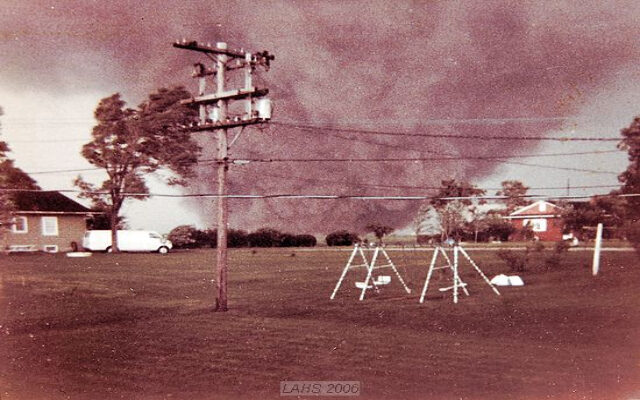46 Years Ago: F4 Tornado Destroys Homes, Kills Two in Lemont

I grew up in Lemont, as did a few generations on both sides of my family. We all have tornado stories to tell. Mine is from 1991, but there’s always one particular day that people remember more than most: June 13, 1976.
I wasn’t born yet. My parents had graduated high school one year prior and were currently dating. It was a hot, sticky Sunday afternoon, and my dad was playing in a recreational softball game at the Lemont Park District on 127th street. My mom, being the huge sports fan she is, was sleeping in the car.
As my mother tells it, everyone at the softball fields that day saw the funnel that had formed just north of downtown Lemont, which was a few miles north of their location. My father woke up my mother from her car-nap and they sprinted with about a dozen or so others to a nearby house to take shelter in the basement. My mother recalls her legs getting cut as they ran through a field to get to the house. When they came out, they found my father’s family home on Walker Road was in the path of the storm and had been destroyed. My mother’s sisters house on 4th street also was flattened. Both were rebuilt.
As you can see in some of the video below, this thing was MASSIVE. The storm was on the ground for nearly an hour, tracking southeast (where most of the damage in town occurred), then north, then northwest where it tore a roof from a building at Argonne National Laboratory. During that time, the tornado traveled an erratic path totaling 8 miles and almost 1,000 meters wide. It caused $13 million in damage and claimed two lives, which is pretty incredible given that warning time for these storms during that time was very short, if any at all.
The National Weather Service has a fascinating summery of the storm, which includes how it the tornado’s path was very odd and erratic, and even saw two smaller tornadoes spin up from the main funnel:
Of particular interest with this tornado was the fact that two satellite anticyclonic (clockwise rotating) tornadoes were produced. In addition, the total time on the ground neared one hour, however the total distance traveled was only about 8 miles. Further research of the storm indicated that the storm was nearly stationary for a period in the tornado’s lifecycle, ultimately contributing to such the short distance traveled.
There are several photos and even a few videos of the story. Some from in town amidst falling debrit. Some from in town, but in sunlight. Even a video taken about 5 miles away in Orland Park! Here’s a video released in October of 1976 and edited by Ted Fujita himself, the weather scientist for whom the tornado strength rating is named.
Factual information for this blog post was taken from the National Weather Service website.





